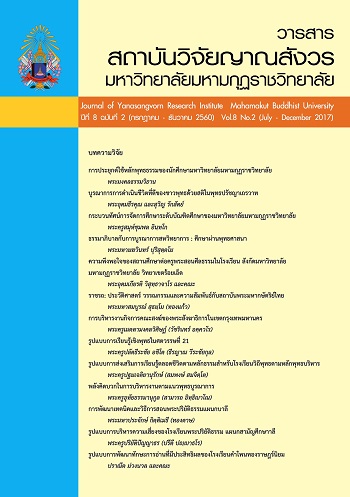INDICATORS OF LEARNING COMMUNITY FOR PERSONNEL UNDER MAHAMAKUT BUDDHIST UNIVERSITY
Main Article Content
Abstract
The purposes of this study were (1) to develop indicators of the structural relationships model of the personnel learning community at Mahamakut Buddhist University and (2) to examine the validity of the model by using empirical data. The indicators with the average values equal to or greater than 3.00 and a coefficient distribution equal to or less than 20% were selected. Data were collected by using the 5-point rating scale with the reliability 0.96 from the 640 staffs at Mahamakut Buddhist University who were proportionally stratified random sampled by using descriptive statistics, referential statistics, statistical software and AMOS software. Results of the study were as follows: 1. The indicators of the structural relationships model of the personnel learning community at Mahamakut Buddhist University consisted of four major elements, 12 sub-elements, and 52 indicators. The “Vision” Element consisted of three sub-elements: 1) Future Vision with seven indicators; 2) The Goal with five indicators; and 3) The Strategy with three indicators. The Teamwork Element consisted of three sub-elements: 1) the Team with seven indicators; 2) the Team Leader with four indicators; and 3) the Team Process with five indicators. The Leader Element consisted of three sub-elements: 1) Knowledge with four indicators; 2) Responsibilities with four indicators; and 3) Participation in the Work with three indicators. All major indicators were averaged and the coefficient of variation for selection of the model indicated the appropriateness level of learning community of personnel at Mahamakut Buddhist University. The average value of 50 indicators equaled to or greater than 3.00 and a coefficient distribution of these indicators equaled to or less than 20%. 2. The elements of the model were consistent with empirical data with the Chi - Square ( ) value equaled to 36.65, the degrees of freedom (df) equaled to 25, the P-value equaled to 0.062, the goodness of fit index (GFI) was 0.99, the adjusted goodness of fit index (AGFI) was 0.97, and the Root Mean Square Error of Approximation (RMSEA) was 0.024.
Article Details
References
____________. (2545). กระบวนการปฏิรูปเพื่อพัฒนาคุณภาพการเรียนรู้ : การประเมินและการประกัน. กรุงเทพฯ : วี ที ซี คอมมิวนิเคชัน.
ประเวศ วะสี. (2549). คุณธรรมนำการพัฒนา ยุทธศาสตร์สังคมคุณธรรม. กรุงเทพฯ : ศูนย์ส่งเสริมและพัฒนาพลังแผ่นดินเชิงคุณธรรม (ศูนย์คุณธรรม) สำนักงานบริหารและพัฒนาองค์ความรู้ (องค์การมหาชน).
วรลักษณ์ ชูกำเนิดและเอกรินทร์ สังข์ทอง. (2557). โรงเรียนแห่งชุมชนการเรียนรู้ทางวิชาชีพครู เพื่อการพัฒนาวิชาชีพครูที่เน้นผู้เรียนเป็นหัวใจสำคัญ. วิทยานิพนธ์ศึกษาศาสตรดุษฎีบัณฑิต, สาขาวิชาการบริหารการศึกษา, บัณฑิตวิทราลัย, มหาวิทยาลัยสงขลานครินทร์.
วีรวุธ มาฆะศิรานนท์. (2545). การพัฒนาวิสัยทัศน์ผู้นำ. กรุงเทพฯ : ธีระป้อมวรรณกรรม.
ศิริวรรณ เสรีรัตน์ และคณะ. (2550). การจัดการและพฤติกรรมองค์การ. กรุงเทพฯ :ธีระฟิล์มและไซเท็กซ์.
Bennis, W. &Nanus, B. (1997).Leaders : Strategies for taking chang. New York : Harper Colins.
DI Hard. (1997). Professional Learning Community (PLC)(ออนไลน์). แหล่งที่มา : http://www.kruinter.com/show.php?id_quiz=3239&p=1 (10 ธันวาคม 2557)
Stronge, J.H. (1998). Leadership skills in school and business ; What theorists say about applying leadership from the corporate world to the school area. American Association of School Administrators -School Administrator. Retrieved Nover 9,2000.

